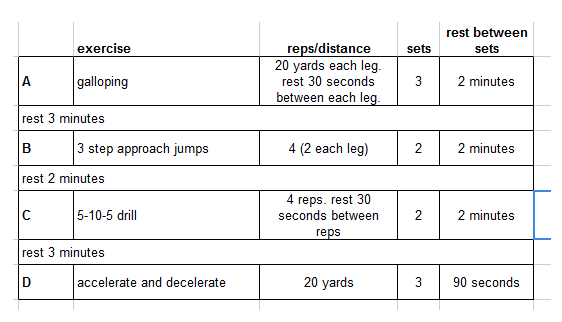Let’s talk SAQ training. SAQ stands for speed, agility, and quickness. We’re talking about training for max effort plays that take just a second – skying someone, juking someone, getting a layout D.
Everyone wants to get better at the athletic qualities that will land them on the highlight reel. But a misunderstanding of how SAQ training works can keep you from being effective in your training. Understanding how SAQ training works will ensure that you’re getting adaptation and not just wasting your training time.
Let’s start with an example….
Typical format of an SAQ module in the Ultimate Athlete Project
This is a module that can be done before any of the other workouts in the program.
As you can see, there is significant rest between reps and also a longer rest period between exercises to endure full recovery before moving on to the next exercise.
The above format is in a phase where SAQ drills are done twice per week. There are many way to format your SAQ training. A very easy way to get started incorporating SAQ training into your existing program is to choose 1-2 drills to do before each workout. This ensures that you don’t get bored and that you’re doing your SAQ work while you are well rested.
Why so much rest?
A common question I get from players who join The Ultimate Athlete Project is, “Why is there so much rest between SAQ drills?”
To understand this you need to understand a bit about the metabolic system that fuels highlight reel plays. The phosphagen system is the metabolic system that produces ATP (required ingredient for muscle contraction) in the shortest amount of time. The phosphagen system is fueled by creatine phosphate (CP) stored in the muscles. The CP must be replenished between bouts of maximal effort work in order for the body to continue producing maximal results.
Too many athletes to not rest sufficiently between plyometric and SAQ drills. The tendency is to want to do more reps and to get in more work. However, doing SAQ work without allowing CP to be replenished will not produce adaptation.
Misconception about Adaptation
Many players train with the belief that as long as you are trying with full intensity, you will increase your vert, get faster, and jump higher. But this is simply not true.
In order to get adaptation to SAQ training, the training stimulus must be done at or above 90% of your current maximum ability. So for example, if your max vertical jump is 20 inches, executing a jump above 18 inches will cause your body to adapt to jump higher. But any jump executed below 18 inches does not promote adaptation. This is why scheduling and planning your SAQ training is so important. Vertical jump training or SAQ drills at the end of practice when you’re too tired to perform near your max capability won’t really get you anywhere.
Being specific about the adaptation you’re looking for (jumping higher) may seem at odds with your desire to be sport specific. After all, on the field you don’t get 2 minutes rest before skying your defender. Counterintuitively, doing vertical jump or agility drills while tired will not help you jump higher or change directions faster while tired. Instead, training for SAQ and vertical jumping while well rested, enhances those qualities and allows your submaximal output on the field to be better.
How much rest?
Full recovery of CP stores can take 2-3 minutes. Does that mean you should rest 2 minutes between reps in your plyometric workout? Not exactly. However, standard practice in SAQ training is a rest:work ratio of 10:1 or 12:1 for max intensity movement. If you’re working on your 3 step approach jump, that takes about 1 second and you’d only need a few seconds before your next repetition. However, if the drill is a serpentine agility drill taking about 10 seconds, you would rest 120 seconds, or 2 minutes. before the next rep if your goal is working on max speed of change if direction.
If you’re working on some light footwork drills, you may not need quite as much rest between reps. In my clinics I try to put people in groups or lines of 6-8 to enforce a rest:work ratio of 5:1 to 7:1
Try it Yourself!
The UAP isn’t currently open, but if you want to put these principles into practice, you can download a free 6 week SAQ and conditioning program here. In my 6 week program, you’ll do about 10 minutes of SAQ work per day. You’ll alternate roughly between linear work (speed, acceleration, and vertical jumping) and multi directional movement work (footwork and agility). The goal is to keep things interesting enough to avoid boredom but get in enough reps to see progress. You could do it differently. This method just keeps things organized and simple.
I hope these principles and my program help you make the type of gains you’re looking for. See you on the highlight reel!












Comments Policy: At Skyd, we value all legitimate contributions to the discussion of ultimate. However, please ensure your input is respectful. Hateful, slanderous, or disrespectful comments will be deleted. For grammatical, factual, and typographic errors, instead of leaving a comment, please e-mail our editors directly at editors [at] skydmagazine.com.